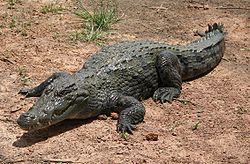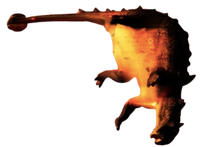
Crocodillian

Crocodilia (or Crocodylia) is an order of mostly large, predatory, semiaquatic reptiles, known as crocodilians. They first appeared 212 million years ago in the Late Triassic period (Norian stage) and are the closest living relatives of birds, as the two groups are the only known survivors of the Archosauria. Members of the order's total group, the clade Pseudosuchia, appeared about 250 million years ago in the Early Triassic period, and diversified during the Mesozoic era. The order Crocodilia includes the true crocodiles (family Crocodylidae), the alligators and caimans (family Alligatoridae), and the gharial and false gharial (family Gavialidae). Although the term 'crocodiles' is sometimes used to refer to all of these, crocodilians is a less ambiguous vernacular term for members of this group.
Large, solidly built, lizard-like reptiles, crocodilians have long flattened snouts, laterally compressed tails, and eyes, ears, and nostrils at the top of the head. They swim well and can move on land in a "high walk" and a "low walk", while smaller species are even capable of galloping. Their skin is thick and covered in non-overlapping scales. They have conical, peg-like teeth and a powerful bite. They have a four-chambered heart and, somewhat like birds, a unidirectional looping system of airflow within the lungs, but like other non-avian reptiles they are ectotherms.
Crocodilians are found mainly in lowlands in the tropics, but alligators also live in the southeastern United States and the Yangtze River in China. They are largely carnivorous, the various species feeding on animals such as fish, crustaceans, molluscs, birds, and mammals; some species like the Indian gharial are specialised feeders, while others like the saltwater crocodile have generalised diets. Crocodilians are typically solitary and territorial, though cooperative feeding does occur. During breeding, dominant males try to monopolise available females. Females lay eggs in holes or in mounds and, unlike most other non-avian reptiles, care for their hatched young.
Some species of crocodilians are known to have attacked humans. The largest number of attacks comes from the Nile crocodile. Humans are the greatest threat to crocodilian populations through activities that include hunting and habitat destruction, but farming of crocodilians has greatly reduced unlawful trading in wild skins. Artistic and literary representations of crocodilians have appeared in human cultures around the world since at least Ancient Egypt. The earliest known mention of the story that crocodiles weep for their victims was in the 9th century; it was later spread by Sir John Mandeville in 1400 and then by William Shakespeare in the late 16th century and early 17th century.
Division[]
Alligatoridae[]
Other[]
Gavialidae
Crocodylidae
|